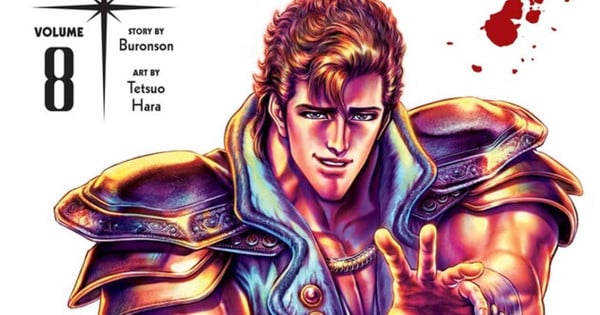Curated From www.animenewsnetwork.com Check Them Out For More Content.
Fist of the North Star Volumes 8 and 9 are, in my opinion, the high watermark of the entire manga and are essential reading for any fan of shōnen fighting series.
In volume 8 we have the battle between Kenshiro and Souther. It is, to use modern parlance, the pinnacle. I mean, it’s the pinnacle as they’re fighting on top of a massive pyramid, but that’s not important right now. What is important is that everything comes together in this perfectly crystallized moment. All the elements that define this series and the broader genre of shōnen fighting converge at this precise juncture, resulting in one of the most thrilling battles imaginable. This is the distilled essence of page-turning comics depicting hot-blooded combat between super-powered warriors.
All the stars have aligned, both figuratively and literally. Kenshiro is fighting for the memory of Shu, someone who played a critical role in his past (revealed through the tried and true method of sudden and dramatic flashback), and whose blood still stains the very steps he treads upon. Souther, on the other hand, fights for more than mere survival; his entire worldview fundamentally opposes Kenshiro’s. He is so dedicated to this opposing viewpoint that he has entombed his master within the pyramid they are fighting on, and conveniently reveals this fact to Kenshiro through a well-placed opening panel. The blood of children, friends, and mentors has been spilled for this cataclysmic struggle beneath the burning stars, with the visions of Raoh and Toki observing from the sidelines.
There is also a literal danger involved in this battle. Souther represents a kind of apex predator in the Nanto Seiken style that Kenshiro has yet to face fully. While there have been dangerous opponents in the past, many of them possessing formidable martial arts skills, some even giving Kenshiro a tough fight, Souther is an entirely different beast. Until this fight, Kenshiro’s opponents often felt powerful due to their sheer strength of personality, will, or a certain ruthlessness that made them dangerous in a way that transcended their martial art. The only time it truly felt like Kenshiro was up against someone whose skill was on the same level as his own was during his battle with Raoh, another Hokuto Shin Ken user.
Souther is a threat because of his personality and because of his martial skill – a rare combination for a Nanto Seiken user. His advantage over Kenshiro comes from knowing how Hokuto Shin Ken works and adjusting his style/body accordingly. This alone makes him a far more interesting villain than many of the other Southern-style users he has come up against. It makes for one of the rare instances where Kenshiro’s actual life is in danger, and there’s tension in whether or not he can win the fight – and that’s saying something given how recently the fight with Raoh was.
The rest of this volume is no sloth either. The four Hokuto brothers are the central drama of this tale, and any time they face off it’s a big deal. So of course the Toki versus Raoh clash is one for the ages. There is also a great use of the flashback here to delve into who these characters are on a fundamental level, with Raoh carrying Toki up the cliffside one-handed feeding well into his present-tense weeping over having to destroy Toki in single combat. The moment where Raoh spares Ryugen’s two sons also stands out as one of the most interesting moments of Raoh taking mercy on anyone in the story and juxtaposes his eventual slaying of the pacifist leader later makes for a fascinating look into his psyche and what he values in others. Those who never give up despite circumstances are to be honored – those who give in no matter how practical are to be admonished. But if circumstances can be changed, they should be, especially to avoid brothers being on the same path.
Volume 9 is similarly packed to the gills with great moments. Though it is somewhat less impactful than volume 8, that’s the nature of a beginning as opposed to a climax. In volume 8 we’re seeing a lot of threads come to a nice (if bloody) resolution. Volume 9 is establishing the tempo for the next arc, so it needs time to build up to the same heights. This is most evident in the first two Goshasei: Huey the wind warrior and Shuren the fire wielder. While they are perfectly fine as far as an enemy of the week combatant goes, there is nothing particularly memorable about them either (other than seeing Raoh fill in for Kenshiro’s typical role of wandering Nanto slayer). It’s hard not to think that they are placeholder villains that Buronson threw in while under the pressure of weekly deadlines to give himself time to come up with stronger stories and characters.
And by God, what great characters Fudo and Juza are. Both are visually distinct and have a lot of texture to their personality, but are fundamentally Fist of the North Star characters: they are mighty warriors beset by tragedy and doomed to violent ends. Fudo’s struggle is interesting as a comparison point to Kenshiro, as both value life but Fudo seems intent on saving the future even at the cost of his own life – Kenshiro is a bit harder-edged, but his victory is more certain. Juza stands out for the tragic nihilism that is born of a love lost due to circumstance. It is also somewhat… interesting to observe that the discovery which makes Juza lose faith is something that forms the actual hook of many series these days. How the times change us.
The art continues to shock and amaze in both volumes. The sheer wanton excess of the violence continues to impress no matter how many times I see it. Bodies getting speared, chunks of face scooped out with casual abandon, heads lopped off as easily as a tee-ball from its perch – there’s no shortage of gruesome and hilarious gore.
If it’s wrong to laugh at a man getting his block knocked off by a giant block of stone, well, then I don’t wanna be right.
The posing and pacing of the fighting are also immaculate, as is to be expected. Every page feels like a Renaissance painting of hell, and every two-page splash looks like the capstone piece of Tetsuo Hara‘s life’s work. Yet it keeps going, every bloody panel and every dramatic battle, it never ceases to amaze.
These chapters embody Tetsuo Hara‘s work at this time – tall, massive frames in iconic poses, facing off against backdrops so stylized the barren wasteland becomes a surreal wonderland. I can only imagine what it took to bring these panels to life, week in and week out, and I am continually grateful that these releases are still coming out. The only caveat is that I wish the commentary we had gotten back in volume 1 had continued through till now.

